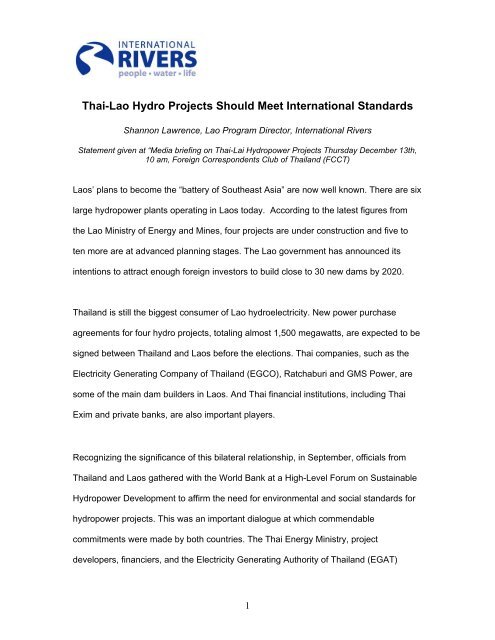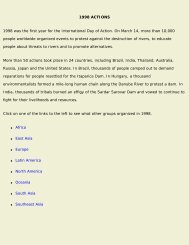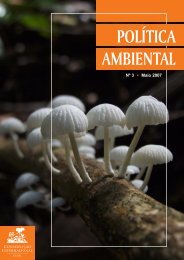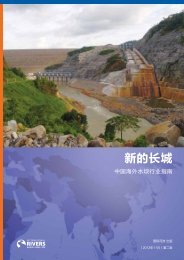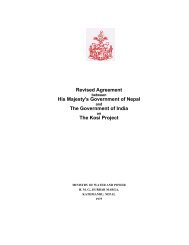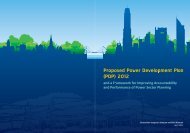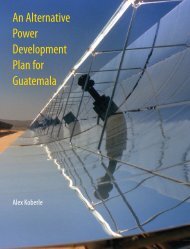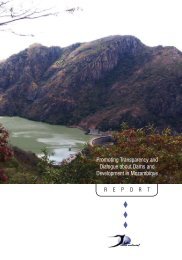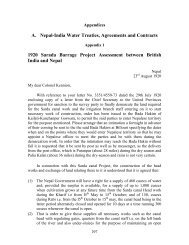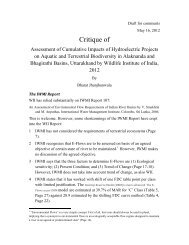Thai-Lao Hydro Projects Should Meet International Standards
Thai-Lao Hydro Projects Should Meet International Standards
Thai-Lao Hydro Projects Should Meet International Standards
Create successful ePaper yourself
Turn your PDF publications into a flip-book with our unique Google optimized e-Paper software.
<strong>Thai</strong>-<strong>Lao</strong> <strong>Hydro</strong> <strong>Projects</strong> <strong>Should</strong> <strong>Meet</strong> <strong>International</strong> <strong>Standards</strong><br />
Shannon Lawrence, <strong>Lao</strong> Program Director, <strong>International</strong> Rivers<br />
Statement given at “Media briefing on <strong>Thai</strong>-Lai <strong>Hydro</strong>power <strong>Projects</strong> Thursday December 13th,<br />
10 am, Foreign Correspondents Club of <strong>Thai</strong>land (FCCT)<br />
<strong>Lao</strong>s’ plans to become the “battery of Southeast Asia” are now well known. There are six<br />
large hydropower plants operating in <strong>Lao</strong>s today. According to the latest figures from<br />
the <strong>Lao</strong> Ministry of Energy and Mines, four projects are under construction and five to<br />
ten more are at advanced planning stages. The <strong>Lao</strong> government has announced its<br />
intentions to attract enough foreign investors to build close to 30 new dams by 2020.<br />
<strong>Thai</strong>land is still the biggest consumer of <strong>Lao</strong> hydroelectricity. New power purchase<br />
agreements for four hydro projects, totaling almost 1,500 megawatts, are expected to be<br />
signed between <strong>Thai</strong>land and <strong>Lao</strong>s before the elections. <strong>Thai</strong> companies, such as the<br />
Electricity Generating Company of <strong>Thai</strong>land (EGCO), Ratchaburi and GMS Power, are<br />
some of the main dam builders in <strong>Lao</strong>s. And <strong>Thai</strong> financial institutions, including <strong>Thai</strong><br />
Exim and private banks, are also important players.<br />
Recognizing the significance of this bilateral relationship, in September, officials from<br />
<strong>Thai</strong>land and <strong>Lao</strong>s gathered with the World Bank at a High-Level Forum on Sustainable<br />
<strong>Hydro</strong>power Development to affirm the need for environmental and social standards for<br />
hydropower projects. This was an important dialogue at which commendable<br />
commitments were made by both countries. The <strong>Thai</strong> Energy Ministry, project<br />
developers, financiers, and the Electricity Generating Authority of <strong>Thai</strong>land (EGAT)<br />
1
acknowledged their responsibility to ensure that the <strong>Lao</strong> dams they support meet<br />
international environmental and social standards.<br />
Across the Mekong, the <strong>Lao</strong> government affirmed the importance of strengthening its<br />
regulatory institutions and policies to secure maximum benefits for <strong>Lao</strong> people. This<br />
follows on the <strong>Lao</strong> government’s adoption, in 2005, of a National Policy on the<br />
Environmental and Social Sustainability of the <strong>Hydro</strong>power Sector.<br />
Yet with the number of proposed dams and the track record of past projects, there are<br />
significant risks that these commitments won’t keep pace and be translated into timely<br />
action. Environmental and social standards are important, but implementation is key.<br />
Right now, <strong>Lao</strong>s’s largest project, Nam Theun 2, is facing a number of challenges in that<br />
regard. I’ve just visited the project area and will briefly highlight some key issues. Erhard<br />
Floether will elaborate further in his presentation, and we’ll be happy to answer<br />
questions or provide more details during the discussion.<br />
Downstream, the Nam Theun 2 project will cause food and income losses for more than<br />
120,000 people who depend on the Xe Bang Fai and Nam Theun rivers. Fish, a staple<br />
food item, will decline. There will be more flooding which will likely impact people’s ability<br />
to grow rice. There will also be increased erosion along parts of the river and water<br />
quality problems.<br />
Implementation of Nam Theun 2’s Downstream Livelihood Restoration Program has<br />
been initiated in only about 20 percent of the more than 220 villages that will be affected<br />
in two years when power production begins. Nam Theun 2’s official monitors, the Panel<br />
of Experts, state in their September 2007 report: “The problem [with the Downstream<br />
2
Program] at this point is that many of the impacts of the project will be felt well before<br />
comprehensive counter measures are in place” (p. 33). The Panel of Experts also points<br />
to the program’s short and long term funding gap; the protein deficiency that is likely to<br />
emerge when fish supplies decrease; and notes that “the existing programs do tend to<br />
look more like a series of essentially unrelated if useful sub-projects than the product of<br />
a coherent plan” (pp. 34-35).<br />
Furthermore, the Nam Theun 2 Power Company and the <strong>Lao</strong> government have still not<br />
reached an agreement on biomass clearance from the reservoir area. Time is running<br />
out, with just over four months remaining before the onset of the rainy season and<br />
reservoir impoundment. While the high-value timber has been removed, additional<br />
biomass clearance is critical to minimize water quality problems in the reservoir and<br />
downstream, and reduce greenhouse gas emissions from the reservoir.<br />
Resettlement on the Nakai Plateau has also suffered from significant delays, although<br />
progress has been made in the construction of resettlement infrastructure in the last<br />
several months. But the key question remains: how will these 6,200 resettlers feed their<br />
families and earn an income when two-thirds of the land they used for farming, animalgrazing<br />
and collecting forest products is under water<br />
And Nam Theun 2 is just one of four existing or proposed dams in the Nam Theun-Nam<br />
Kading river basin. About 40 kilometers downstream from Nam Theun 2, the <strong>Thai</strong>-<br />
Norwegian Theun-Hinboun <strong>Hydro</strong>power project has been generating electricity for<br />
<strong>Thai</strong>land since 1998. A report released last month by Norwegian NGO FIVAS details<br />
increasingly severe flooding along the Hai and Hinboun Rivers over the last nine years,<br />
largely due to water releases from the project. Around 30,000 people have suffered<br />
3
declines in fish and other aquatic resources, for which the company has paid no<br />
compensation. They have also been forced to abandon their paddy fields due to the<br />
repeated loss of wet season rice crops. The flooding has caused water contamination,<br />
skin diseases, drinking water shortages, death of livestock from drowning and disease,<br />
and other temporary food shortages.<br />
Yet the project’s operators, Statkraft and GMS Power of <strong>Thai</strong>land, are now proposing an<br />
expansion to account for the reduction in flows caused by Nam Theun 2’s development<br />
upstream. The Theun-Hinboun Expansion Project would double the diversion to the Hai<br />
and Hinboun, making life for tens of thousands of people living along those rivers<br />
increasingly intolerable. This new project does not include adequate measures to<br />
mitigate the flooding and erosion problems, nor does it provide compensation to address<br />
villagers’ past – and ongoing – losses.<br />
The Theun-Hinboun Expansion Project is one of the four power purchase agreements<br />
with <strong>Thai</strong>land that are expected to be signed by the end of this year. But it should not go<br />
forward until and unless the Company has resolved the problems with the existing<br />
project. Murray Watson will discuss these issues in more detail.<br />
Another one of these four projects, the Nam Theun 1 dam, would be built downstream<br />
from Nam Theun 2 and Theun-Hinboun, just about 30 kilometers from the Mekong<br />
confluence. This <strong>Thai</strong>-Malaysian dam sponsored by Gamuda and EGCO would be built<br />
in the middle of <strong>Lao</strong>s’ remote Nam Kading National Protected Area, in an area classified<br />
by conservation organizations as one of 35 global biodiversity “hotspots”. Its reservoir<br />
would effectively divide the protected area in two, destroying large swathes of riverine<br />
and terrestrial wildlife habitat. Hunting and poaching pressures are already on the rise;<br />
4
and even before an environmental impact assessment has been approved, roads<br />
constructed for the project have reached the national park. Reports indicate that more<br />
than 3,500 people will be displaced to make way for Nam Theun 1, and that<br />
communities downstream can expect decreases in water flows, water quality, and<br />
fisheries. Nam Theun 1’s economic viability has also been questioned, especially<br />
considering the development of the Theun-Hinboun Expansion Project upstream.<br />
Given Nam Theun 1’s significant social and environmental costs – many of which simply<br />
cannot be mitigated -- this project undermines the sustainable hydropower pledges<br />
made by the <strong>Thai</strong> and <strong>Lao</strong> governments in September. The Theun-Hinboun Expansion<br />
Project, with its failure to address the legacy of downstream livelihood losses, also fails<br />
to meet these standards.<br />
Committing to and implementing high social and environmental standards benefits all<br />
parties. It reduces the financial and reputational risks for <strong>Thai</strong> project developers and<br />
their financial backers. It shields the <strong>Thai</strong> government from criticism that it has<br />
externalized the social and environmental costs of its energy consumption to its <strong>Lao</strong><br />
neighbors. Most importantly, it reduces the potentially devastating effects of these<br />
projects on <strong>Lao</strong> people and the threat they pose to the <strong>Lao</strong> government’s poverty<br />
reduction plans. New hydropower projects that fall short of these standards, such as the<br />
Theun-Hinboun Expansion Project and Nam Theun 1, should be dropped.<br />
5


